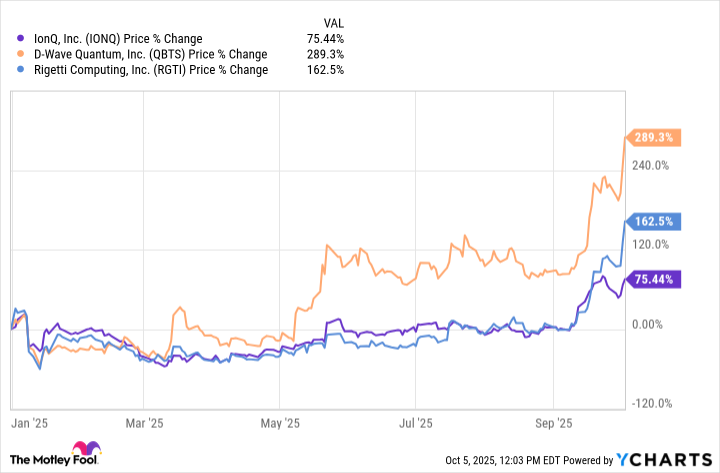The quantum computing rally of 2025 defies conventional logic. IonQ (IONQ 0.68%) up 75%, D-Wave Quantum (QBTS 0.75%) up 289%, Rigetti Computing (RGTI 1.69%) up 162% -- all since January.
The catalysts are legitimate. China just demonstrated a 12,900-kilometer quantum satellite link. DARPA pledged $1 billion to achieve utility-scale quantum computing by 2033. The U.S. government is scrambling to deploy quantum-resistant encryption before "Q-Day" -- the moment when quantum computers become powerful enough to break current encryption standards, threatening everything from bank transactions to national security.
With institutional money flooding in and governments treating quantum as a national security priority, these stocks might be worth the premium despite astronomical valuations. Each company has made breakthroughs suggesting one could capture a market McKinsey estimates will reach $850 billion by 2040.

Image source: Getty Images.
But are the pure play quantum computing stocks actually buys in October? Let's examine each company's technology and financials to find out.
Room temperature advantage
IonQ stands out by avoiding the cryogenic cooling that most quantum competitors require. Its trapped-ion systems operate at room temperature, a potential advantage for scaling and cost efficiency. The recent $1 billion Oxford Ionics acquisition targets 800 logical qubits by 2027, and partnerships with AstraZeneca and Amazon Web Services point to commercial applications starting to form. The balance sheet remains strong with about $1.6 billion in cash after a mid-2025 raise.

NYSE: IONQ
Key Data Points
The challenge is valuation. IonQ trades at more than 300-times trailing sales, with revenue projected to reach about $100 million in 2025 and profitability unlikely before 2030. This valuation only makes sense if trapped ions prove to be the winning approach in quantum computing, despite competition from IBM, Microsoft, and Alphabet with much larger budgets.
Optimization over universal
D-Wave's quantum annealing technology focuses on optimization problems such as routing, scheduling, and portfolio management. A pilot with North Wales Police showed the potential -- deployment puzzles that took classical systems four months were solved in four minutes, cutting response times in half. The sixth-generation Advantage2 system is already delivering measurable enterprise value.

NYSE: QBTS
Key Data Points
D-Wave's valuation remains the key hurdle. Analysts see only $70 million to $75 million in annual revenue by 2027, yet the company trades at more than 300-times trailing sales. Even with July's $400 million raise, bringing cash to $819 million in the most recent quarter, the gap between current valuation and projected revenue growth is wide. Without faster adoption, the rally risks outrunning fundamentals.
A bold valuation
Rigetti Computing continues to push the envelope in quantum hardware. The company has demonstrated 99.5% two-qubit gate fidelity, roughly doubling the fidelity of earlier systems, and secured a $35 million investment from Quanta Computer as part of a broader $200 million technology partnership. The U.S. Air Force awarded $5.8 million for quantum networking research with Rigetti, and the company plans to debut a 100-qubit system later this year.

NASDAQ: RGTI
Key Data Points
But the financials tell a harsher story. In its latest quarter, Rigetti's revenue fell 42% year-over-year to about $1.8 million, while it posted a net loss of $40 million. Its cash reserves of $572 million offer somewhat of a runway, but the burn rate is steep compared to commercial traction. At above 1,100-times sales, the valuation essentially assumes that Rigetti's technical edge will translate into real customers and deals -- a leap no amount of circuit-level performance guarantees.
Speculation at any speed
The disconnect between promise and profit has never been wider. These companies face massive cash burn while competing against tech giants with virtually unlimited resources. This technology will transform computing, but picking winners among cash-burning start-ups requires extraordinary conviction about which approach ultimately succeeds.
For speculators comfortable losing everything, it might be smart to allocate 1% to 2% of your portfolio maximum across all three. For investors seeking growth at reasonable prices, look elsewhere. The fact of the matter is that the quantum computing rally prices in perfection from companies still years away from profitability. Revolutionary technology at extreme valuations has historically been a challenging combination for investors, regardless of the ultimate success of the underlying innovation.
